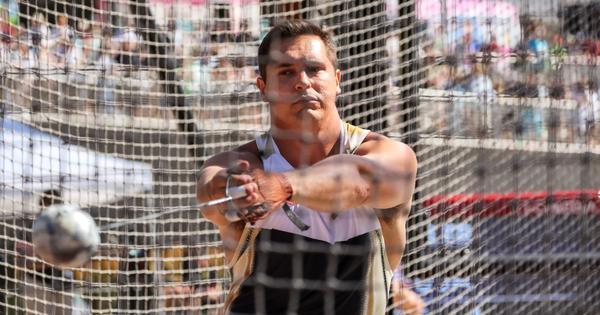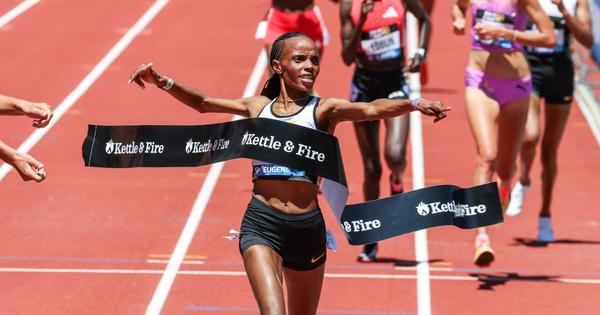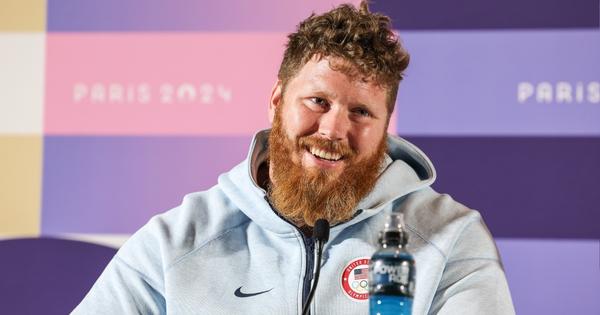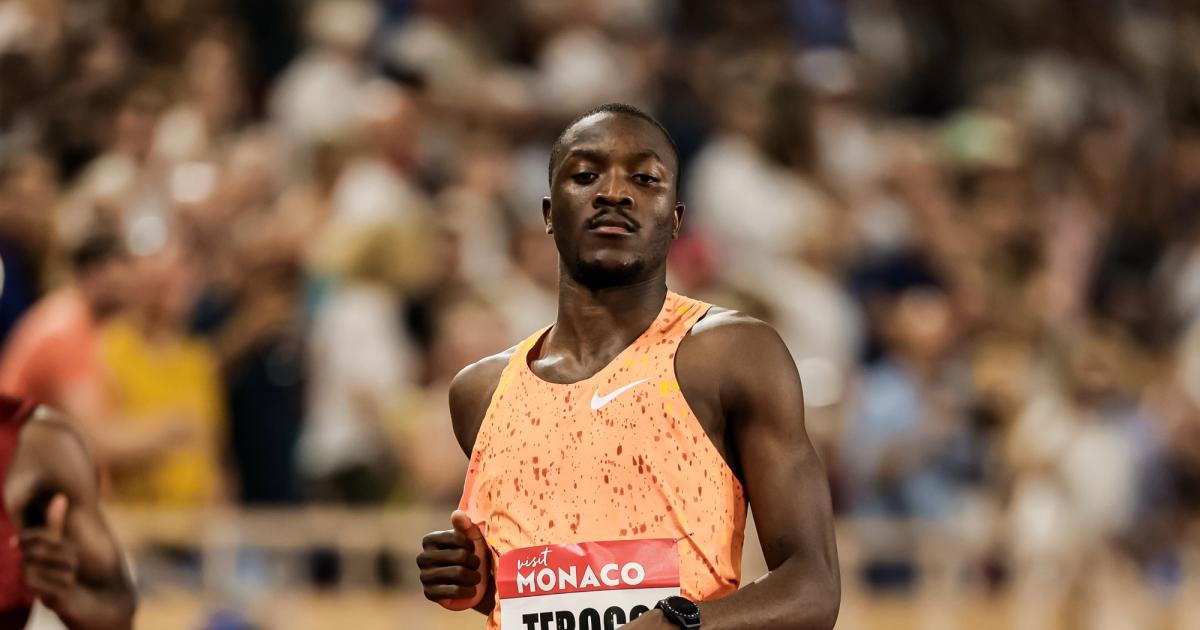By Paul Hof-Mahoney
July 9, 2025
You may have missed it entirely on TV, but the 50th Prefontaine Classic wasn’t just a great track meet. It was a historically great FIELD meet as well. Six simple numbers do a great job of capturing what made Pre50 probably the best single day in the history of throwing heavy things far: 83.16m, 78.88m, 70.97m, 70.68m, 22.48m, 20.94m. Those were the winning marks, in order, for men’s and women’s hammer, discus and shot put in Eugene.
For all you distance runners feeling your eyes glazing over and your scrolling finger getting itchy, let’s break ‘em down:
83.16m, Rudy Winkler: Winkler enjoyed an incredible 2021 season coming out of the pandemic, posting three marks over 81.44m, including the American record of 82.71m. He hadn’t matched that form in the years since, but he’s been on a roll in 2025 and a 45cm PB is the perfect example of that. He downed Olympic and World champ Ethan Katzberg (81.73m), who was nigh untouchable in 2024, and claimed the world lead and the 18th spot on the world all-time list.
78.88m, Camryn Rogers: Any time a World/Olympic champion sets a PB, that’s a pretty good day! It had been over two years since Rogers last set her best mark, but she smashed through that barrier in the fourth round after three good-but-not-groundbreaking throws to open. Since 2023, women’s hammer has seen tons of volatility at the biggest stages, but Rogers has been steady. She brings it when the moment requires it. She jumped from sixth to fifth on the all-time list. Brooke Andersen put up a great fight, tossing three bombs over 76m and five over 75.30m, and seven-time global champ Anita Włodarczyk continued her road back to true contention with a SB of 74.70m.
70.97m, Mykolas Alekna: On paper, Alekna’s mark isn’t quite as gaudy as the two we’ve hit on already. It’s only the sixth-best mark of his career, but it means more under the surface. Throwing in a stadium versus a field can be a big difference maker in discus, and this is the best Alekna has ever thrown in a stadium three weeks after, for all intents and purposes, choking at NCAAs. Collegiate champ Ralford Mullings had another good day in Hayward, going 68.98m, but the world record holder and newly-quacking Oregon Duck was on another level. Two throws over 70m, five over 69.50m is one of the very best in-stadium series in world history. THAT’S how you bounce back.
70.68m, Valarie Allman: What more is there to really say at this point? This was simply “Val being Val.” 26 wins in a row against the best in the world, a nearly three-meter win (which is honestly a little closer than these things sometimes are), three throws at 69.48m or better. Nobody can beat Allman, only the dark magic that has afflicted her the last two editions of Worlds. And with every passing meet, the streak gets more improbably impressive.
22.48m, Joe Kovacs: Kovacs most certainly deserves his flowers for winning, claiming the world lead, and tacking nearly a meter onto his season’s best, but the true story of this comp was spread throughout the field. After years of Crouser and Kovacs and co. making 22m the new 21m, 2025 has been starkly different for global shot putting. No man had thrown 22m until Leo Fabbri did so on June 8th, and only Payton Otterdahl had joined him heading into last weekend. The dam broke open in the hallowed Hayward ring, though, as five men threw over 22m in the same competition for the first time ever.
20.94m, Chase Jackson: The first 21-meter throw by a woman in checks calendar 4,740 days is getting closer. After throwing 20.95m a week earlier at the Iron Wood Classic in Idaho, Jackson came a whisker away from cracking that barrier in the same ring she threw 20.76m back in 2023. Her series was better this time around, the alarmingly big practice throws are still there, and for the first time in a long time 21m feels like a matter of when, not if. Just like the men’s competition, the story extended beyond the winner, as five women broke 20m for the first time since the 1988 Olympic final (which may or may not have had a bit of dubious assistance).
But how much of that would you all know if you only watched the broadcast?
Nobody involved in track and field broadcasting has quite cracked the code for showcasing the throws as they unfold. For existing hardcore fans, dedicated streams like the ones at global and U.S. championships are a godsend, but that doesn’t do much for growing a broader appreciation for the throws. A sprints fan isn’t likely to flip on a javelin stream given the option, even if they have the ability to watch two streams at once. Obviously it’d be unrealistic to argue for every throw to be shown, but there’s opportunities for growth in coverage to not make the throws feel like filler or an afterthought.
A typical Diamond League broadcast might show us about four throws per competition: the leader’s best throughout the first five rounds, and then the final throw for each of the top three in the DL’s controversial new format. Often, most if not all those attempts aren’t really shown live-live. A good start to this would be more regular check-ins with the throws throughout the competition, so viewers have a better understanding of the flow of the competition and storylines that are building throughout.
The rivalries that so often build suspense and catch eyes in the track events exist inside the oval as well! There’s a lot of cameras at a meet—throw one of them on Ethan Katzberg as he watches Rudy Winkler snatch the win and world lead from his neighbor to the north. Imagine the tension of following Allman around as she heads into her fifth or sixth attempt sitting in second place with her streak on the line. “The thrill of victory and the agony of defeat” is something you can show in this way to produce immediate stakes and intrigue. People love joy and people love misery. People need to see a winner and a loser, and their raw reactions to those results shaking out.
Broadcasters also make a huge difference. Throwing is a niche, and highly technical, but perhaps counterintuitively, the best way to convey everything that makes throwing special to the everyday fan is to lean into the technicality in presentation. Have someone who actually knows what they’re talking about in the booth, like Olympic shot put veteran Darrell Hill. He’s been a breath of fresh air on recent Peacock broadcasts, bringing insights on technique between throws and offering context on athletes’ stories. And it’s not like throw series are wildly time-consuming – there’s about a minute gap between each throw, which a good commentator can easily fill with technical insight or stakes-setting.
It’s not easy to carve out time in a jam-packed broadcast like Pre, but other meets—even other Diamond Leagues—have much more dead air. So why not fill it with the greatness already at your fingertips? Practically every event is in the midst of the best era its ever seen, and throwers can be some of the most endearing and entertaining personalities in the sport. There are ways to grow, and that can start as we come off the heels of the best day in throwing history.

Paul Hof-Mahoney
Paul is currently a student at the University of Florida (Go Gators) and is incredibly excited to be making his way into the track and field scene. He loves getting the opportunity to showcase the fascinating storylines that build up year-over-year across all events (but especially the throws).




